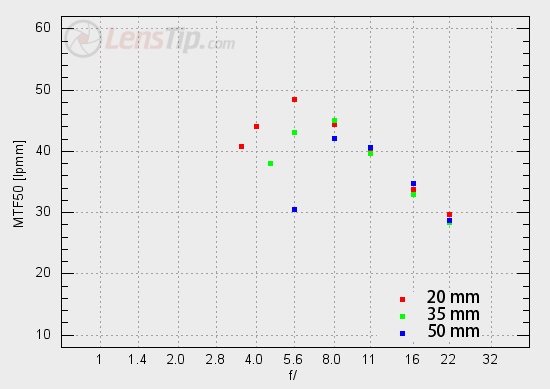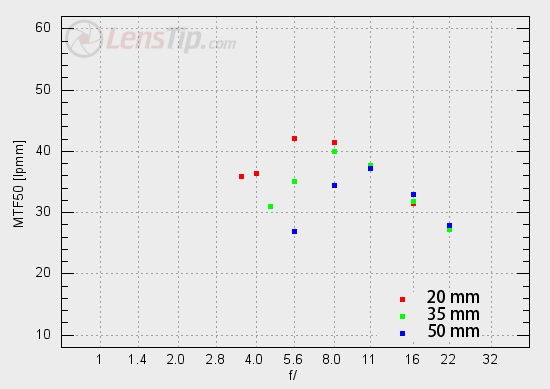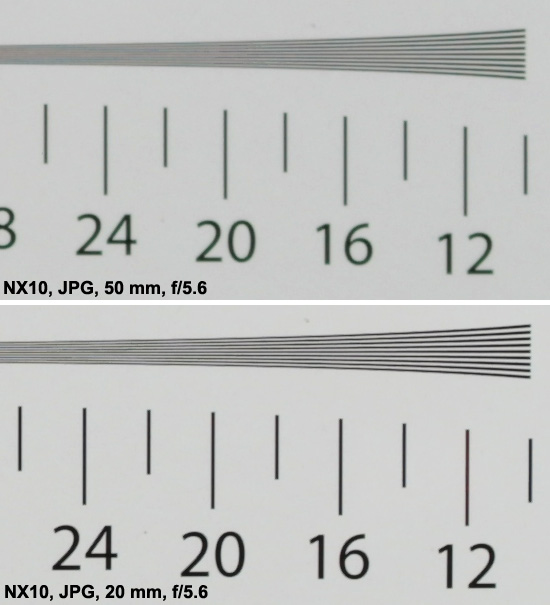Samsung NX 20-50 mm f/3.5-5.6 ED
4. Image resolution
Let’s have a glance at a graph with the tested lens’s results in the frame centre.

Please Support UsIf you enjoy our reviews and articles, and you want us to continue our work please, support our website by donating through PayPal. The funds are going to be used for paying our editorial team, renting servers, and equipping our testing studio; only that way we will be able to continue providing you interesting content for free. |
- - - - - - - - - - - - - - - - - - - - - - - - - - - - - - - - - - - - - - - - - - - - - - - -
If you consult these numbers, only one expression comes into your mind – a decent lens. They are perhaps not breathtaking but at the widest focal lengths the tested Samsung really shouldn’t be ashamed of its performance. At 20 mm the lens’s achievements are similar (but a bit worse) than those of the system Samsung NX 30 mm f/2.0. The 50 mm focal length when wide open might let down a bit though– the lens decreases below the decency level there. You can’t overlook the fact that the resolution decreases here significantly by f/5.6 but in this category that combination is the only one weak spot of the tested Samsung.
Of course the comparison between such results and those of the standard NX system kit will be very interesting. You can notice two kinds of changes. For wide angle focal lengths, ending near 35 mm, the Samsung NX 20–50 mm f/3.5–5.6 is minimally better but at the longest focal length when wide open the standard kit lens prevails. The new device’s design was better thought out but still you had to pay for smaller, more compact dimensions – the combination of the longest focal length and the maximum relative aperture was apparently chosen as a king of scapegoat here. The Samsung NX 20–50 mm f/3.5–5.6 reaches lower resolution results than the kit device from other mirrorless system of similar class so the Sony E 18–55 mm f/3.5–5.6 OSS attached to the Sony NEX-5. You should always remember of course about significant discrepancies between those two when it comes to the dimensions and weight and also about the differences between the sensors, mentioned by us at the beginning. When you take these into account the two lenses become significantly more alike.
Now let’s consult the resolution graph for the edge of the frame.

The frame edge performance is less encouraging but still the decency level, characteristic for most of kit lenses, is kept. At most combinations of focal lengths and apertures the resolution values either exceed or are just on the borderline of the 34 lpmm which is the decency level; at the widest focal length the device even managed to exceed 40 lpmm in the range of apertures from f/5.6 to f/8.0. It is hardly a surprise that the combination of the longest focal length and the maximum relative aperture falls short of our expectations, as it was the case in the frame centre. Limiting the focal range definitely helped the Samsung NX 20-50 mm f/3.5-5.6 if you compare its results to those of the NX system kit lens. When at 35 mm they fare very much alike, the extreme focal lengths (different of course) perform better in the case of the tested lens. The same is true if you compare the Samsung with the Sony, already mentioned here – still keeping in mind its wider 18-55 mm focal range of course.
Significantly reduced dimensions could have made you anxious about the compromises Samsung had to come to while designing this lens. Fortunately the tests showed that when it comes to resolution we get similar or even better results than in the case of the NX kit. The way the tested lens fares at the longest focal length and f/5.6 aperture is the only complaint here.
You should be careful, though, if you want to compare the resolution of this instrument with other kit lenses. Firstly this lens is significantly smaller than most of them. A narrower range of focal lengths might not be able to make up for a simpler optical design, entailing probably worse optical performance. It can be noticed very clearly if you compare the tested lens with a bit better resolution-wise but also a lot bigger Sony E 18–55 mm f/3.5–5.6 OSS. Secondly although the tested instrument’s design resembles the kit Olympus M.Zuiko Digital 14–42 mm f/3.5–5.6 ED, that one is often used on more densely-packed Micro Four Thirds sensors.
At the end of this chapter we present our test chart crops taken from JPEG files which were saved along with RAW files with sharpening level set on minimum.
 |






